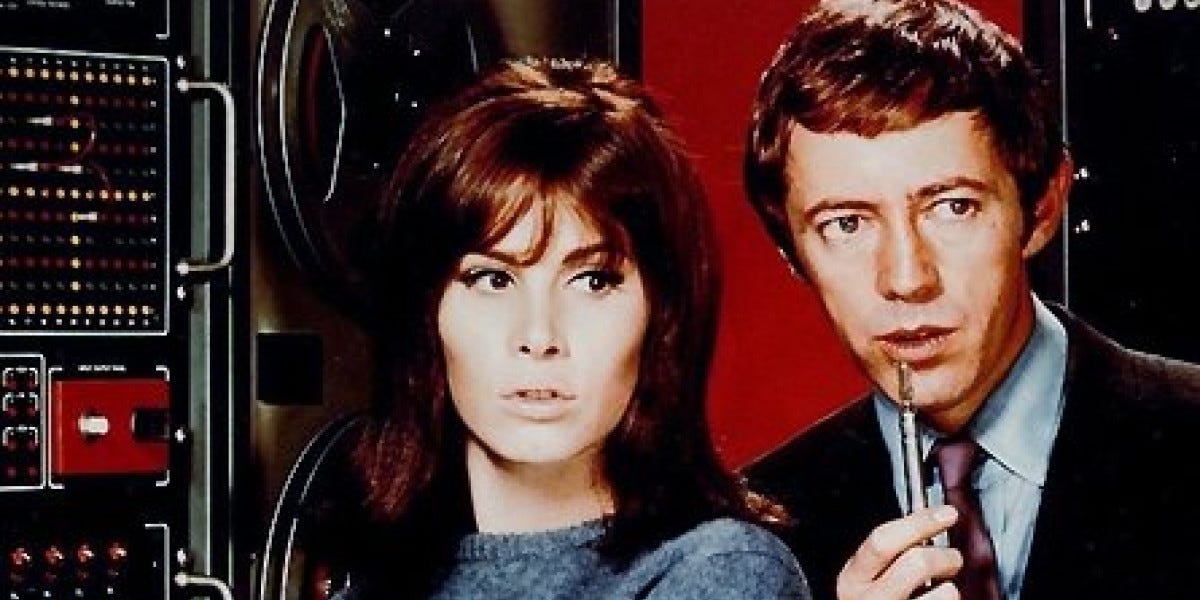Review of The Girl from U.N.C.L.E. (1966–1967)
The Girl from U.N.C.L.E., a spin-off of the popular The Man from U.N.C.L.E., aired on NBC for one season from September 1966 to April 1967. Starring Stefanie Powers as April Dancer, the first female enforcement agent for the United Network Command for Law and Enforcement (U.N.C.L.E.), and Noel Harrison as her British partner Mark Slate, the show aimed to capitalize on the 1960s spy craze. With Leo G. Carroll reprising his role as U.N.C.L.E. chief Alexander Waverly, the series promised a fresh take on the espionage genre with a female lead. However, despite its vibrant energy and campy charm, the show struggled to find its footing, resulting in a mixed legacy.
Plot and Premise
The Girl from U.N.C.L.E. follows April Dancer and Mark Slate as they tackle missions to thwart the evil schemes of THRUSH and other villains. The show blends spy-fi action with tongue-in-cheek humor, featuring outlandish plots like slow-motion devices, piranha-filled pools, and brainwashing gadgets. Introduced via a backdoor pilot, "The Moonglow Affair," in The Man from U.N.C.L.E., the series leaned heavily on its parent show’s formula, complete with Jerry Goldsmith’s iconic theme music rearranged by Dave Grusin. Episodes often placed April in undercover roles, from fashion buyers to go-go dancers, emphasizing her charm and resourcefulness over physical combat.
Strengths
The show’s greatest asset is its campy, lighthearted tone, which aligns with the 1960s spy genre’s playful excess. Stefanie Powers, only 23 at the time, brings a radiant charisma to April Dancer, making her a compelling figure even when the scripts falter. Her chemistry with Noel Harrison’s Mark Slate adds a fun dynamic, with Harrison often stealing scenes with his suave, understated wit. The series also boasts an impressive roster of guest stars, including Boris Karloff in the delightfully bizarre "The Mother Muffin Affair" and Stan Freberg in a comedic turn. The vibrant 1960s aesthetic—colorful fashions, mod sets, and groovy soundtracks—shines through, especially on DVD where the vivid colors pop compared to the black-and-white TVs of the era. For fans of the era’s spy-fi, episodes like "The Moulin Ruse Affair" deliver entertaining stunt work and absurdly fun premises, such as ancient Burt Mustin wreaking havoc on U.N.C.L.E. headquarters.
Weaknesses
Despite its potential, The Girl from U.N.C.L.E. is hampered by inconsistent writing and questionable creative choices. Contemporary reviews, such as those from The Baltimore Sun and Newsday, criticized Powers’ performance as limited, though this seems harsh given her youth and the scripts’ constraints. More problematic is the show’s tendency to portray April as a damsel in distress, frequently knocked out or kidnapped, relying on gadgets like knockout gas rather than showcasing her as a competent equal to her male counterparts. This contrasts sharply with The Avengers’ Emma Peel, whose strength and wit set a high bar for female spies. Critics like Kay Gardella of the New York Daily News noted April’s “less than undergraduate skill” in spying, and the show’s reliance on Mark Slate to handle much of the action often undermines its feminist premise. Plots, while enjoyably absurd, could feel repetitive or poorly developed, with some scripts—like Richard Matheson’s "The Atlantis Affair"—failing to live up to their potential. The show’s scheduling against established hits like Daktari and Combat! also didn’t help its ratings.
Cultural Context and Legacy
Airing during the peak of the 1960s spy craze, The Girl from U.N.C.L.E. faced stiff competition and suffered from comparisons to its parent series, which was itself veering into sillier territory by its third season. The decision to recast April Dancer (from Mary Ann Mobley in the pilot to Powers) and Mark Slate (from Norman Fell to Harrison) disrupted the chemistry established in "The Moonglow Affair," a move some fans still lament. The show’s failure to secure a second season—coupled with its perceived role in The Man from U.N.C.L.E.’s cancellation—earned it a reputation as a “bad spin-off.” However, modern viewers, particularly on platforms like Amazon and IMDb, appreciate its nostalgic charm, with some praising Powers’ appeal and the show’s unapologetic camp. The 2011 DVD release by Warner Archive has helped revive interest, offering a chance to enjoy its 29 episodes in crisp quality.
Verdict
The Girl from U.N.C.L.E. is a flawed but endearing relic of 1960s pop culture. Its campy plots, vibrant visuals, and likable leads make it a fun, if uneven, watch for fans of retro spy dramas. While it doesn’t match the sophistication of The Avengers or the polish of its parent series, it offers enough quirky moments and nostalgic appeal to warrant a revisit. Approach it with a sense of humor and an appreciation for the era’s excesses, and you’ll find a show that’s more entertaining than its reputation suggests. For those who enjoy lighthearted espionage with a side of 1960s flair, it’s worth checking out—perhaps with a glass of wine to enhance the experience, as one IMDb reviewer humorously suggested.
Rating: 3/5 stars
Recommended for: Fans of The Man from U.N.C.L.E., 1960s spy shows, or anyone with a soft spot for campy nostalgia.



